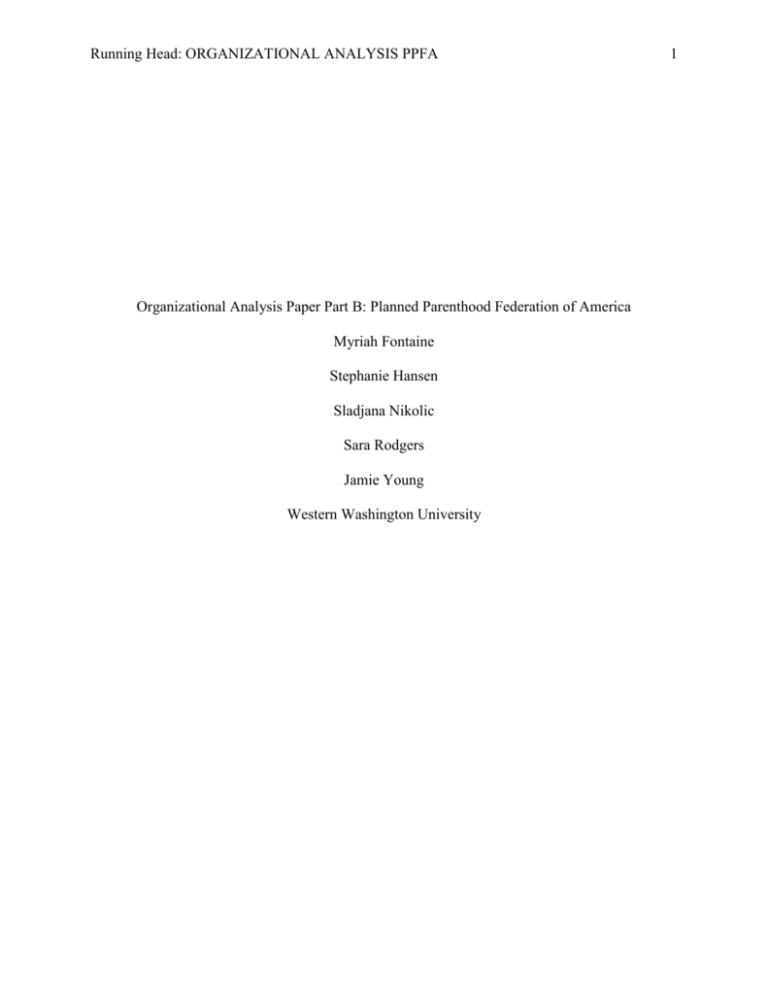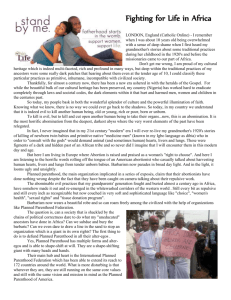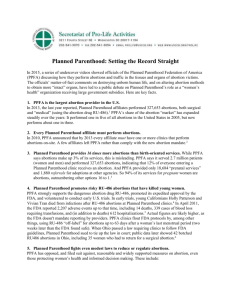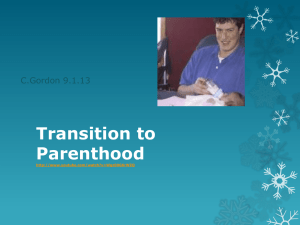
Running Head: ORGANIZATIONAL ANALYSIS PPFA
Organizational Analysis Paper Part B: Planned Parenthood Federation of America
Myriah Fontaine
Stephanie Hansen
Sladjana Nikolic
Sara Rodgers
Jamie Young
Western Washington University
1
ORGANIZATIONAL ANALYSIS PPFA
2
Table of Contents
Introduction………………………………………………………………………………………..3
History and Mission………………………………………………………………………….……3
Lifecycle Stages of PPFA………………………………………………………………………....4
Nonprofit Status……………………………………………………………………………….….5
Services……………………………………………………………………………………….…..6
Clients Served…………………………………………………………………………………….7
Board of Directors and Management Team………………………………………………………8
Financial Information…………………………………………………………………………....10
PPFA SWOT Analysis Chart……………………………………………………………………11
SWOT Reflective Analysis…………………………………………………………………...…11
Conclusion……………………………………………………………………………………....13
Appendix A……………………………………………………………………………………..15
References………………………………………………………………………………………17
ORGANIZATIONAL ANALYSIS PPFA
3
Organizational Analysis Paper Part B: Planned Parenthood Federation of America
Introduction
In the nonprofit sector, health services are the largest of all subsectors when measured by
all revenue, expenditures, and/or number of employees (Worth, 2014, p. 31). Health services was
one of the first subsectors of the nonprofit arena to become professionally managed by
employing professional paid staff as an alternative to volunteers; it is also one of the most
commercialized subsectors (Worth, 2014, p.31). Planned Parenthood Federation of America
(PPFA) is one of the organizations that provides health services and advocates for clients’ rights
to health services.
History and Mission
Margaret Sanger founded Planned Parenthood Federation of America (PPFA) in 1916
when she opened the first birth control clinic in Brooklyn, New York (PPFA6, n.d.). Although
the first clinic was quickly shut down, Sanger continued to fight for her vision and in 1923 she
opened another clinic, the Birth Control Clinical Research Bureau in Manhattan. In Manhattan
she was able to provide contraceptives to women while collecting data about the safety and
effectiveness of them (PPFA6, n.d.). By 1966 PPFA had grown from the small clinic in
Manhattan to a nationally recognized organization that revolutionized sexual health care for
women. Over the years Sanger worked to build and grow her vision of PPFA to the large
nonprofit organization it is today. Planned Parenthood still bases its mission on the efforts and
vision Sanger fought to bring into the mainstream (PPFA6, n.d.). Planned Parenthood Federation
of America’s mission statement is (PPFA3, n.d.),
ORGANIZATIONAL ANALYSIS PPFA
-
4
Provide comprehensive reproductive and complementary health care services in
settings which preserve and protect the essential privacy and rights of each
individual
-
To advocate public policies which guarantee these rights and ensure access to
such services
-
To provide educational programs which enhance understanding of individual and
societal implications of human sexuality
-
To promote research and the advancement of technology in reproductive health
care and encourage understanding of their inherent bioethical, behavioral, and
social implications (PPFA3, n.d.)
Life Cycle Stages of PPFA
Worth, 2014 describes the 5 different stages an organization goes through as:
Stage 1: Imagine and inspire
Stage 2: Found and frame
Stage 3: Ground and grow
Stage 4: Produce and sustain
Stage 5: Review and renew
- Stage 1: In the early stages of PPFA, Sanger was eager and full of energy while working to get
the organization off the ground and although it was not yet founded she had clear dreams of what
the organization would look like.
-Stage 2: As her vision became reality there was a great deal of excitement about what the
organization could be for women as people started to stand behind her mission and her dream,
helping to get PPFA off the ground.
ORGANIZATIONAL ANALYSIS PPFA
5
-Stage 3: Sanger was challenged at every turn, even being arrested for ordering and receiving
birth control through the mail (PPFA6, n.d.). However, there were also triumphs through the
challenges that first came when, “Judge Augustus Hand, writing for the U.S. Circuit Court of
Appeals, orders a sweeping liberalization of federal Comstock laws, ruling that contemporary
data on the damages of unplanned pregnancy and the benefits of contraception mean that
contraceptive devices and birth control could no longer be classified as obscene” (PPFA6, n.d.).
Sanger and her followers continued to fight for contraceptive freedom and by 1960 they saw the
FDA approve the sale of contraceptive pills and by 1966 the pill was available to women all over
the country (PPFA6, n.d.).
-Stage 4: PPFA continued to grow into an n nonprofit 503(c) (3) organization, becoming stable
and mature. Worth (2014) describes this life stage as one were a nonprofit may lose its edge and
is at risk of losing momentum and failing. However, PPFA continued to grow and gain support.
-Stage 5: PPFA is constantly adding services and changing their programs to accommodate
health care needs. They are in a continuous battle with lawmakers and people in society who
challenge PPFA and the services they provide. However, this has not stopped them from growing
but has forced them to revisit their programs and change as needed to keep services available.
Nonprofit Status
Planned Parenthood Federation of America is a 501(c)(3) nonprofit organization that
provides many different services which nationwide, “operates approximately 700 health centers”
(PPFA5, n.d.). They offer a wide range of services and programs that represent the many diverse
needs of the different communities it serves. Nonprofits exist to serve a social purpose that has
been viewed to be of public benefit, even controversial issues where there is a debate on whether
or not it's a benefit; such as pro-life or pro-choice positions (Worth, 2014). As stated by Worth
ORGANIZATIONAL ANALYSIS PPFA
6
(2014), "in such cases, the public benefit that all of them advance is the protection and
encouragement of free and open debate, a value presumably shared by those on all sides of an
issue in a democratic society"(p.57).
Services
Planned Parenthood Federation of America (PPFA) is based on the fight for women's
health, rights, and equality and their services provided reflect that basis (PPFA4, n.d.). The main
categories of services provided are abortion, birth control, body image counseling, general health
care, men's sexual health, morning-after pill (emergency contraception), pregnancy counseling,
information about relationships, sex & sexuality, sexual orientation & gender, sexually
transmitted diseases (STD's), and women's health (PPFA4, n.d.). PPFA explains each category as
follows:
Abortion is a safe and legal way to end a pregnancy. Learning more about abortion
methods and options can help you decide if abortion is the right choice for you. There are many
ways to prevent pregnancy. Learn more about birth control, and find the method that's best for
you. We all have ideas and feelings about how we look. Learning more about body image can
help you stay healthy — mentally and physically. Along with reproductive care, many Planned
Parenthood health centers provide additional health services. Some sexual health issues only
affect men. We’re here to answer your questions and help you protect your health. Emergency
contraception safely and effectively prevents pregnancy up to five days after unprotected sex.
How does pregnancy happen? What are your pregnancy options? How do you stay healthy when
you’re pregnant? We have the answers you need. Learning how to have a great relationship —
and how to recognize an unhealthy one — can help keep you safe and happy. Understanding
your anatomy, who you’re attracted to, and what gives you pleasure can improve your quality of
ORGANIZATIONAL ANALYSIS PPFA
7
life and help you take charge of your sexual health. Sexual orientation and gender are unique
and important parts of who we are. Learn more about what it all means. Infections can be
passed between people during sexual contact. Learn more about STD symptoms, testing,
treatment, and how to reduce your risk. Lots of sexual and reproductive health issues only affect
women. We’ve got the facts you need to get healthy and stay healthy. (PPFA4, n.d.)
The extensive and growing list of services provided by PPFA benefits the public of the
United States of all ages, races and genders. It is a safe environment, free of judgment for people
to seek counsel and request services that may be thought to be controversial and/or taboo in
today's society. PPFA is keeping up with the fast paced technology of today with its innovative
video visits. "If you live in Minnesota or Washington State, you can have a video visit with one
of our providers online, and then receive the birth control pill, patch, or ring in the mail. Always
discreet, always secure, conveniently available. The care you need, when you need it." (PPFA4,
n.d.).
Clients Served
Planned Parenthood Federation of America provides essential reproductive healthcare,
sex education, and information to millions of men, women and youth of all backgrounds without
discrimination (PPFA5, n.d.). There are over 66 Planned Parenthood affiliation locations across
the United States, with at least one Planned Parenthood office in each state and some states have
several locations throughout their state (PPFA2, n.d.). "The heart of Planned Parenthood is in the
local community. Our 66 unique, locally governed affiliates nationwide operate approximately
700 health centers, which reflect the diverse needs of their communities" (PPFA5, para.4, n.d.).
ORGANIZATIONAL ANALYSIS PPFA
8
Board of Directors and Management Team
The definitive duty of the governing board of a nonprofit organization is to make certain
the organization fulfills its mission and has the general welfare of the organization in focus
(Worth, 2014). There are many terms used to describe governing boards and some organizations
have multiple governing boards, depending on the size and scope of the organization. Planned
Parenthood Federation of America has a small four-person board of directors and an extensive
seventeen-person senior management team. The Planned Parenthood Federation of America
Board of Directors 2012-2013 (PPFA1, n.d.) is as shown below:
Chair: Alexis
McGill Johnson
Vice Chair:
Naomi Aberly
Treasurer: Lou
Zellner
Secretary:
Veronica Dela
Rosa
ORGANIZATIONAL ANALYSIS PPFA
9
Planned Parenthood Federation of America Senior Management Team 2012-2013 (PPFA1, n.d.):
President: Cecile
Richards
Executive Vice
President & Chief
Operating Officer: Lisa
David
Executive Vice
President & Chief
Development Officer:
Sandy Sedacca
Executive Vice
President & Chief
Experience Officer:
Dawn Laguens
Chief Human
Resources Officer:
Marvin Russell
Chief Information
Officer: Tom Subak
Chief Financial Officer:
Wallace D. Souza
Senior Vice President
& General Counsel:
Debra Alligood White
Vice President, Global:
Latanya Mapp Frett
Vice President, Health
Information
Technology & Business
Inititives: Eileen Twiggs
Vice President,
Education: Leslie
Kantor
Vice President,
Affiliate Services:
Molly Eagan
Vice President,
External Medical
Affairs: Vanessa
Cullins, M.D., M.P.H,
M.B.A.
Vice President,
Communications: Eric
Ferrero
Vice President Public
Policy & Government
Relations: Dana
Singiser
Vice President,
Information Services:
Rebecca Willett
Senior Medical
Advisor: Carolyn
Westhoff, M.D.
ORGANIZATIONAL ANALYSIS PPFA
Financial Information
A balance sheet provides a snapshot of the organization, usually at the end of the fiscal
year, to summarize its assets, liabilities, revenues, and expenses (Worth, 2014). By looking at
Planned Parenthood Federation of America's combined balance sheet (Appendix A), it clearly
shows assets, liabilities, revenue and expenses. Approximately 45% of the Planned Parenthood
Federation of America's revenue comes from government health services grants and
reimbursements; about 26% is coming from private contributions and bequests; about 28% is
coming from a combination of non-government health services revenue and other operating
revenue (PPFA1, n.d.). The financial future of Planned Parenthood Federation of America
appears to be positive with their excess of revenue over expenses totaling $58.2 million for the
end of the 2012-2013 fiscal year (PPFA1, n.d.).
10
ORGANIZATIONAL ANALYSIS PPFA
11
PPFA SWOT Analysis Chart
Strengths
Long successful history- almost
100 years in existence with 66
independent locally owned
chapters and over 700 health
centers
Health Centers accessible and
strategically located in communities
Each affiliate office independently
operates to meet local needs
Leading reproductive rights
advocate and health care provider
Opportunities
Recent changes in healthcare
expansion and adaption of the
Affordable Care Act, additional
millions of people got access to
insurance and the PPFA services
Over 50% increase in chapters on
college campuses last year
Local and national foundation
support
Provide variety of services,
programs, and opportunities for
growth
Weaknesses
Hard to find more detailed
information online about the
organization e.g. vision statement
National and local administration
staff not responsive or accessible
to general inquiries.
Controversial – people are unsure
of services provided by the
organization
Threats
Political opposition- the Tea party
Religious pro-life opposition
Competition from other providers
due to the nature of changes. For
instance possible changes in
military laws when reproductive
care will be supported.
Controversial- provocative issues
that have a history of challenges
with opposition
(PPFA1, n.d.)
SWOT Reflective Analysis
Just like any other organization, in Planned Parenthood there are various strengths,
weaknesses, opportunities and threats. This organization has been around for almost 100 years,
offering their services to the public, which is a tremendous strength. They offer a wide variety of
services that range from simple health exams or educational pamphlets to birth control and
abortion. As discussed previously, one of the main concerns for the clients of Planned
Parenthood is to be a nonjudgmental and educational facility and this is what appeals to the
ORGANIZATIONAL ANALYSIS PPFA
12
public. Stated on their website they describe their approach as “based on respect for each
individual’s right to make informed, independent decisions about health, sex, and family
planning” (PPFA5, n.d.). People want to get answers to their questions and possible solutions to
their issues and do so without being judged or made feel like they are doing something wrong.
Caring about your sexual health should not be wrong or looked down upon, which coincides with
the values of PPFA.
However, it appears that PPFA may have a major weakness. Unfortunately, there seems
to be quite a bit of controversy with this organization, regardless of the positive appeal they have
on those wanting education, answers or any of the many other services offered. There are plenty
of offices around the Pacific Northwest and without a doubt there is always a chance of seeing a
group of people protesting outside one of the Planned Parenthood buildings. It seems they are
mostly protesting because of one particular service that is offered: abortion. Some blogs or
articles say the abortion is only a small percentage of what is really done and some say it is one
of the larger percentages of services done so it may be difficult to find a definite answer. The
service is offered and used and this is still unsettling to many people. It is what stirs such a
controversy with those who do not support the decision to have an abortion.
There is an opportunity that has risen for Planned Parenthood in terms of health care and
that would be the Affordable Care Act (ACA). Planned Parenthood adopting the ACA to their
insurances can open up more doors to patients who otherwise may not be able to access the
services Planned Parenthood offers. They have an estimate calculator that will be on their
website by 2015 in order for people to estimate the cost of various things, based on their income
and household size.
ORGANIZATIONAL ANALYSIS PPFA
13
There seems to be one major threat to this organization and it is similar to what was
discussed as their weakness. Those who are pro-life are people will not be accessing this facility,
because abortion is offered. It is strong religious feelings or personal beliefs that keep people
away from the doors of Planned Parenthood. Those who don’t believe in abortion, either because
of personal values or religious upbringing, are a huge population of people fighting against or not
supporting this organization. Seeing their signs of protest outside of a Planned Parenthood
building can certainly deter a returning patient or new client. This is what can be seen as one of
the biggest threats to the organization, represented by the people standing outside, protesting and
holding signs featuring unpleasant messages about abortion. It could cause many eligible clients
to reject the services of the organization.
Conclusion
With a history of advocating for client’s health rights and providing services since 1916,
it’s not surprising that the Planned Parenthood Federation of America’s management system
would be fairly complex. The organization maintains a strategy surrounding its mission of
providing reproductive healthcare, advocating public policies, providing educational programs,
and promoting research (PPFA3, n.d.). When viewed through the lens of Worth’s 5
organizational stages, it is evident that the management team are faced with a constantly growing
and changing organization, at the same time attempting to fit the needs of their clients and fulfill
the organization’s mission (Worth, 2014).
Planned Parenthood Federation of America makes its services available in every state
while at the same time battling the stigma and controversy that have surrounded the organization
from the beginning (PPFA4, n.d.). These actions are led by both a small, 4-member board of
directors as well as a larger senior management team, working to realize the organization’s goals
ORGANIZATIONAL ANALYSIS PPFA
14
(PPFA1, n.d.). Within the workings of the organization, information can be found showing the
wide variety of funding gained by PPFA as part of its strategy, including a large amount of
remaining revenue to enhance its current programs and services (PPFA1, n.d.).
Using the SWOT (strengths, weaknesses, opportunities, threats) chart, as demonstrated in
Worth’s Nonprofit Management: Principles and Practice (2014), helped provide information
about the dynamics of the organization faced by the management team when attempting to make
decisions about all aspects of the organization. It can be seen that strengths in the organization,
such as a history of widespread service, are corresponded by weaknesses, such as defensiveness
surrounding its controversial nature. Following this, the chart shows us that opportunities, such
as growth and new changes in health care, are contradicted by threats, such as political
opposition to services. Generally speaking, all of the complexities of the organization come
together to provide a sense of how Planned Parenthood Federation of America manages and
views its different systems to continue to provide the communities of the United States with the
services it believes those communities are entitled to.
ORGANIZATIONAL ANALYSIS PPFA
15
Appendix A
A.1.
(PPFA1, P.18, n.d.)
ORGANIZATIONAL ANALYSIS PPFA
A.2.
(PPFA1, P.20, n.d.)
16
ORGANIZATIONAL ANALYSIS PPFA
17
References
Planned Parenthood Federation of America1. (n.d.). Annual Report 2012 - 2013: Planned
Parenthood. Retrieved from: http://www.plannedparenthood.org/about-us/annual-report
Planned Parenthood Federation of America2. (n.d.). Local & State Offices. Retrieved from:
http://www.plannedparenthood.org/about-us/local-state-offices
Planned Parenthood Federation of America3. (n.d.). Mission. Retrieved from:
http://www.plannedparenthood.org/about-us/who-we-are/mission
Planned Parenthood Federation of America4. (n.d.). Sexual Health Topics. Retrieved from:
http://www.plannedparenthood.org/health-info
Planned Parenthood Federation of America5. (n.d.). Who We Are. Retrieved from:
http://www.plannedparenthood.org/about-us/who-we-are
Planned Parenthood Federation of America6 ,(n.d.) Who We Are, History Retrieved from:
http://www.plannedparenthood.org/about-us/who-we-are/history-successes
Worth, M. (2014). Nonprofit management: Principles & Practice (3rd Ed.). Thousand Oaks, CA:
Sage Publications.








